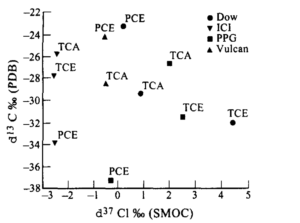ENVIRONMENTAL FORENSICS
Isotope analysis are becoming of common use in judicial fields. The possibility of revealing and dating pollution events with better precision are key-aspects for attributing contaminant pools to responsible parties. Nowadays, many case studies have made use of CSIA in front of a layer whenever responsibilities were not clear, especially at complex contaminated sites.
What are the Benefits of CSIA?
CSIA is a well-developed tool for environmental forensics and environmental litigation, where source apportionment and contaminant “fingerprinting” are required. Isotope analysis can be used to differentiate source materials and release points at complex sites where multiple plumes are contributing to the concentration of a given contaminant, or a single contaminant is contributing over multiple release times.
The ability of traditional isotope analysis to accurately “fingerprint” source materials is dependent on:
- the contaminant of interest;
- how isotopically distinct the source materials are, i.e. are the differences in their isotopic values greater than any analytical uncertainties associated with sample preparation and isotope analysis;
- do any biotic or abiotic processes occur along the flow path that alter the observed isotopic values.
CSIA greatly improves upon the ability of traditional isotope analysis for environmental forensics, by allowing for additional dimensions for source separation.
The increased sensitivity for source signature determination can be observed in Figure 2, where CSIA for both δ13C and δ37Cl were carried out to distinguish chlorinated solvents from different manufacturers. These distinct source values allow for CSIA to be used for source discrimination and additional delineation of the pathways and processes altering the concentration of chlorinated solvents, as they move through the natural environment.

Figure 2: Dual isotope plot of δ13C and δ37Cl values for three chlorinated solvents (perchloroethylene, PCE; trichloroethylene, TCE; and 1,1,1 – trichloroethane, TCA) from four chlorinated solvent manufacturers (Van Warmerdam et al., 1995).

